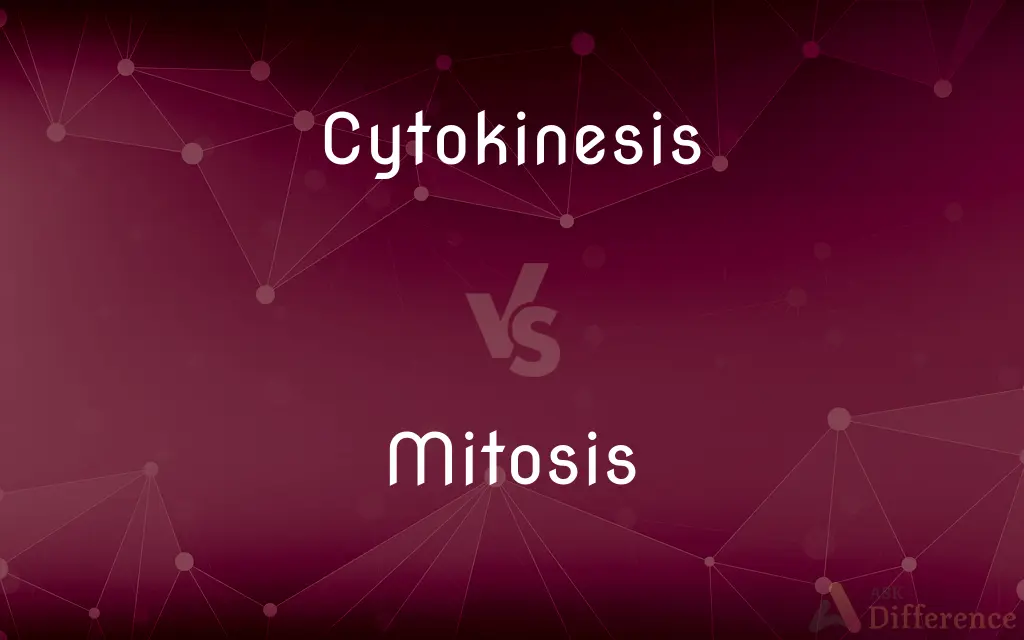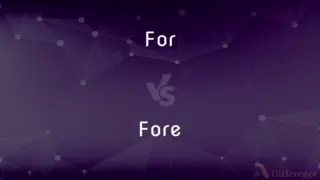Cytokinesis vs. Mitosis — What's the Difference?
Edited by Tayyaba Rehman — By Urooj Arif — Updated on April 17, 2024
Cytokinesis divides the cell's cytoplasm, forming two cells, whereas mitosis is the division of a cell's nucleus, ensuring equal chromosome distribution.

Difference Between Cytokinesis and Mitosis
Table of Contents
ADVERTISEMENT
Key Differences
Cytokinesis is the process that usually occurs after mitosis, involving the division of the cell's cytoplasm into two daughter cells. Whereas mitosis involves the division of the cell's nucleus and ensures that each daughter cell receives an identical set of chromosomes.
Cytokinesis begins during the late stages of mitosis, often during telophase, while mitosis itself progresses through distinct phases: prophase, metaphase, anaphase, and telophase.
Cytokinesis involves the formation of a cleavage furrow in animal cells or a cell plate in plant cells, which ultimately separates the cell into two. On the other hand, mitosis meticulously aligns chromosomes at the cell's equator and separates them to opposite poles of the cell.
The regulation of cytokinesis is tightly coordinated with the stages of mitosis, ensuring that it does not commence until chromosome segregation is nearly complete. Whereas the regulatory mechanisms of mitosis include complex checkpoints that guarantee the fidelity of chromosome separation before cytokinesis can begin.
Comparison Chart
Definition
Division of the cell's cytoplasm.
Division of the cell's nucleus.
ADVERTISEMENT
Main Purpose
To physically separate the daughter cells.
To ensure equal genetic material in daughter cells.
Occurs in
All cells undergoing division.
All cells undergoing division.
Key Features
Cleavage furrow in animals,cell plate in plants.
Chromosome alignment and separation.
Compare with Definitions
Cytokinesis
Regulated by signals ensuring it does not begin until mitosis is complete.
The onset of cytokinesis is controlled to prevent premature separation of the cell.
Mitosis
Characterized by spindle apparatus formation, which helps in chromosome movement.
The spindle fibers attach to chromosomes during mitosis to guide their division.
Cytokinesis
Characterized by the physical separation of cytoplasmic contents.
Cytokinesis ensures that each daughter cell receives sufficient organelles and cytosol.
Mitosis
The process of nuclear division in eukaryotic cells that ensures each daughter cell receives identical chromosomes.
Mitosis is crucial for tissue growth and repair.
Cytokinesis
The process in which a cell's cytoplasm divides, creating new cell boundaries.
Cytokinesis in animal cells involves the formation of a cleavage furrow that deepens until the cells are pinched in two.
Mitosis
Includes checkpoints that ensure errors are corrected before cell division proceeds.
Mitosis has a checkpoint to verify that all chromosomes are properly aligned before they are separated.
Cytokinesis
The final step in cell division, following mitosis.
During cytokinesis in plant cells, a cell plate forms gradually at the site of division.
Mitosis
Involves distinct phases: prophase, metaphase, anaphase, and telophase.
Chromosomes are most visible during metaphase of mitosis.
Cytokinesis
Often associated with the construction of new cellular structures to enclose each daughter cell.
In cytokinesis, the cell membrane and cell wall (in plants) must reform around the new cells.
Mitosis
Maintains the chromosome number by equally dividing replicated chromosomes.
During anaphase of mitosis, sister chromatids separate to opposite poles of the cell.
Cytokinesis
Cytokinesis () is the part of the cell division process during which the cytoplasm of a single eukaryotic cell divides into two daughter cells. Cytoplasmic division begins during or after the late stages of nuclear division in mitosis and meiosis.
Mitosis
In cell biology, mitosis () is a part of the cell cycle in which replicated chromosomes are separated into two new nuclei. Cell division gives rise to genetically identical cells in which the total number of chromosomes is maintained.
Cytokinesis
The division of the cytoplasm of a cell following the division of the nucleus.
Mitosis
A type of cell division that results in two daughter cells each having the same number and kind of chromosomes as the parent nucleus, typical of ordinary tissue growth
The single large egg cell subdivides by repeated mitosis
Each mitosis seems to be associated with an increase in calcium
Cytokinesis
(biology) The process in which the cytoplasm of a cell divides following the division of the nucleus.
Mitosis
The process in cell division by which the nucleus divides, typically consisting of four stages, prophase, metaphase, anaphase, and telophase, and normally resulting in two new nuclei, each of which contains a complete copy of the parental chromosomes.Also called karyokinesis.
Cytokinesis
Organic process consisting of the division of the cytoplasm of a cell following karyokinesis bringing about the separation into two daughter cells
Mitosis
The entire process of cell division including division of the nucleus and the cytoplasm.
Mitosis
(cytology) The division of a cell nucleus in which the genome is copied and separated into two identical halves. It is normally followed by cell division.
Mitosis
See Karyokinesis.
Mitosis
Cell division in which the nucleus divides into nuclei containing the same number of chromosomes
Common Curiosities
At what stage of the cell cycle does cytokinesis occur?
Cytokinesis typically occurs after mitosis, during the late stages of cell division.
What structures are involved in cytokinesis in plant and animal cells?
In animal cells, a cleavage furrow forms; in plant cells, a cell plate forms.
What is the main function of cytokinesis?
To physically separate the cytoplasm and contents of a cell into two daughter cells.
Can mitosis occur without cytokinesis?
Yes, some cells, like certain cancer cells and cells undergoing certain developmental processes, may undergo mitosis without cytokinesis, leading to multinucleated cells.
What happens if cytokinesis is incomplete?
Incomplete cytokinesis can lead to cells with more than one nucleus, affecting cell function and development.
What ensures that cytokinesis does not start prematurely?
Cytokinesis is regulated by internal cell cycle checkpoints that ensure it only starts after mitosis is nearly complete.
Why is mitosis important for an organism?
Mitosis is crucial for growth, tissue repair, and replacement of old or damaged cells with genetically identical ones.
What role does the spindle play in mitosis?
The spindle helps in the proper alignment and separation of chromosomes during mitosis.
What occurs first, mitosis or cytokinesis?
Mitosis occurs first, followed by cytokinesis.
How do cytokinesis and mitosis contribute to cell regeneration?
They work together to ensure that new cells are created with proper genetic and physical properties for tissue regeneration.
Are there cells that only undergo cytokinesis without mitosis?
Typically, no; cytokinesis usually follows mitosis to ensure proper division and distribution of cellular contents.
How does mitosis differ from cytokinesis in terms of function?
Mitosis divides the nucleus to ensure equal chromosome distribution, while cytokinesis divides the cytoplasm to form two separate cells.
How are the processes of mitosis and cytokinesis coordinated?
They are tightly coordinated through molecular signals to ensure proper timing and execution of cell division.
How do the outcomes of mitosis and cytokinesis differ?
Mitosis results in two nuclei, while cytokinesis results in the complete formation of two separate cells.
Can errors in mitosis affect cytokinesis?
Yes, errors in mitosis can lead to incorrect chromosome number or distribution, which may disrupt normal cytokinesis and cell function.
Share Your Discovery

Previous Comparison
Snowstorm vs. Blizzard
Next Comparison
For vs. ForeAuthor Spotlight
Written by
Urooj ArifUrooj is a skilled content writer at Ask Difference, known for her exceptional ability to simplify complex topics into engaging and informative content. With a passion for research and a flair for clear, concise writing, she consistently delivers articles that resonate with our diverse audience.
Edited by
Tayyaba RehmanTayyaba Rehman is a distinguished writer, currently serving as a primary contributor to askdifference.com. As a researcher in semantics and etymology, Tayyaba's passion for the complexity of languages and their distinctions has found a perfect home on the platform. Tayyaba delves into the intricacies of language, distinguishing between commonly confused words and phrases, thereby providing clarity for readers worldwide.















































